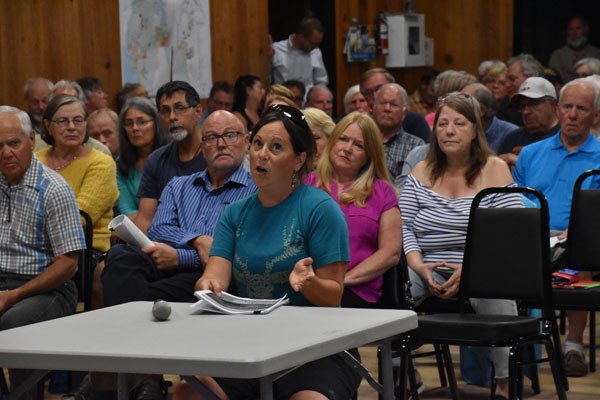Pender Harbour could have a brand new Official Community Plan for the first time since 1998, but residents aren’t satisfied with all of the proposed changes, specifically how the shíshálh Nation Strategic Land Use Plan (SLUP) is integrated into the bylaw. They spiritedly voiced their discontent at a public hearing in Madeira Park on Sept. 5.
Moderating the hearing was Area A director Frank Mauro and Halfmoon Bay director Garry Nohr. Sunshine Coast Regional District (SCRD) chief administrative officer Janette Loveys and planning manager Andrew Allen, the OCP’s author, were also present.
The new bylaw contains a raft of updates, from the inclusion of a vision statement, boundary changes, updated geotechnical hazard areas, updated land use designations to recommendations for a harbour management plan and plans to create zoning for water bodies, as well as zoning updates to reflect current settlement.
These updates were largely ignored though, and instead the two-hour meeting was dominated by criticisms of another change: the inclusion of Part Four, a section that summarizes and references three regional planning documents, the most contentious of which is the shíshálh Nation SLUP. The SLUP, published roughly 10 years after the current Pender Harbour OCP was passed as a bylaw, is a guiding document for land use management in the traditional territory of the shíshálh Nation, which encompasses the land subject to the Pender Harbour OCP.
Nearly everyone who picked up the microphone at the packed Pender Harbour Community Hall spoke against the SLUP inclusion, their arguments frequently punctuated with enthusiastic applause. Nohr’s request at the hearing’s start that attendees refrain from clapping because “it intimidates others who might have a different point of view” was met with vociferous jeers.
During the new OCP’s referral process, the Egmont/Pender Harbour Advisory Commission had requested that chapters in Part Four be replaced with links to the related documents rather than be included as summaries, arguing those documents weren’t central to the OCP.
That request was repeated near the start of the hearing by OCP advisory committee chair Peter Robson. Speaking independently of that committee, he called it “a very good document” overall before outlining his concern that “no one can verify any of the information” contained in the land use documents.
Robson said he was “especially concerned” with the inclusion of the shíshálh Nation SLUP because “it means the people of Area A agree with their history, territorial boundaries and traditional land uses.” He said he was worried the shíshálh Nation could use the SLUP’s inclusion in the OCP as evidence in a future land claim case.
“I believe [it is the] responsibility of an OCP to acknowledge First Nations traditional territory and consult under circumstances, but I don’t believe it is the responsibility of an OCP to give legitimacy to the shíshálh land use plan. That is something for the province and the band to work out.”
Bill Charlton challenged the hearing’s process by circulating a petition requesting the introduction to Part Four be reworded and that a sentence be added stating the inclusion of the summaries is “not to be construed as an admission of the alleged facts contained therein.” Charlton said he collected approximately 200 signatures by the end of the hearing, which was delayed in order to allow him to submit them.
Other arguments were grounded in economics. Near the end of the hearing, a local builder commended the OCP and acknowledged the shíshálh Nation’s right to preserve their heritage, but said she was worried about “a large economic impact,” on development projects.
One resident was more direct. He received loud applause and whistles after declaring, “This is a title war and everyone needs to stand up for their own rights and their own title.”
Several residents also said the document and its relationship to the SLUP was too complex, which makes it unapproachable for average citizens. Others spoke out against the public engagement process, which they said wasn’t as extensive at it should have been. One resident said given the OCP’s substantial changes, “one opportunity for public input in November and a public hearing in the middle of the week just two days past Labour Day and on very short notice in the summer period” was inadequate. She said this was particularly problematic for seasonal residents.
Staff said they had recommended holding the public meeting the week after the Labour Day long weekend “in order to enable participation from both local and off-Coast property residents and owners.”
Pending any recommended changes to land use and density within the OCP, the bylaw could be introduced for third reading and adoption following the Oct. 11 planning and community development meeting.



